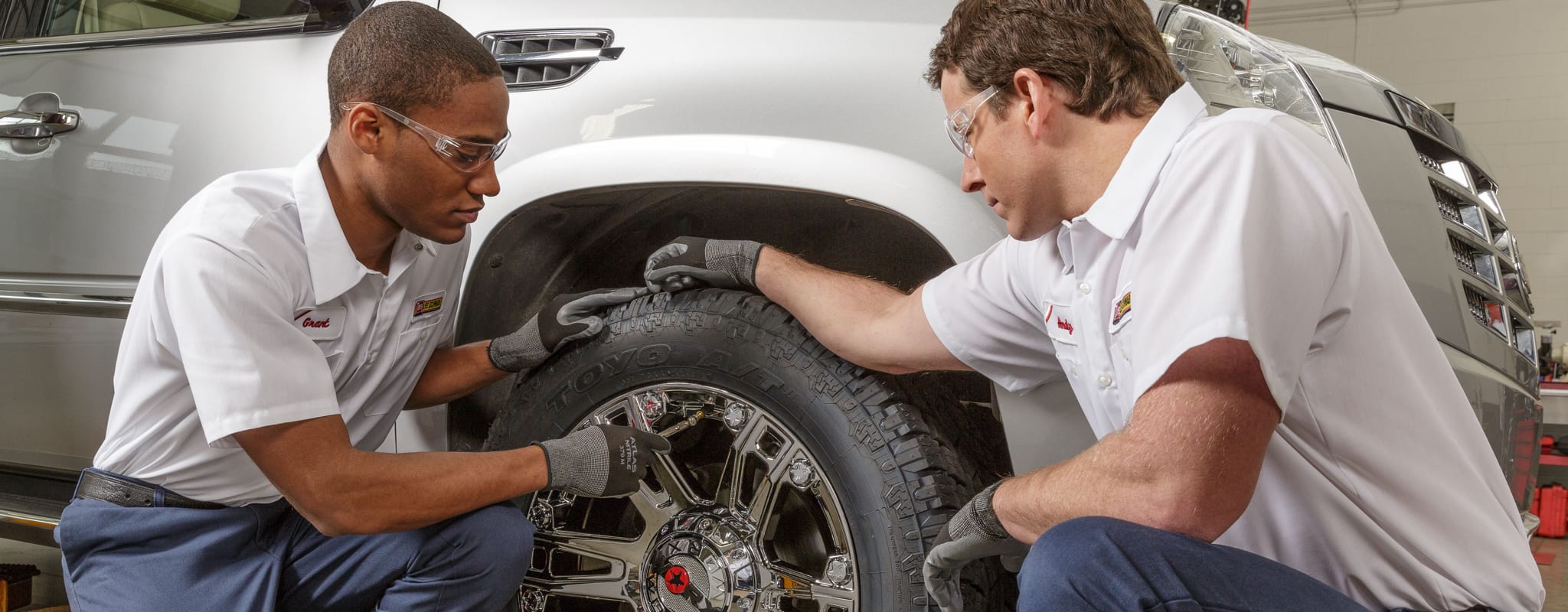Tire Solution: The Effect of Weather Condition Conditions
When it comes to making certain optimum efficiency and safety and security on the roadway, understanding the influence of climate problems on tire solution is vital. GMC Tire Service. In this conversation, we will explore the elaborate partnership in between weather conditions and tire service, shedding light on the value of weather-specific tire maintenance techniques and considerations.
Heat and Tire Performance
When exposed to high temperature levels, tires experience changes in efficiency that can dramatically impact car safety and handling. The heat produced from long term driving or heat problems causes the tire rubber to soften, bring about reduced tread life and raised wear. As the rubber becomes softer, the tire's grip when driving reduces, influencing braking ranges and overall traction. In severe situations, extreme warmth can also trigger tire blowouts, positioning a severe safety and security threat to the car and its residents.

Winter Effects
Cold climate problems can have a substantial effect on tire efficiency and security. As temperature levels decrease, tire rubber can set, bring about lowered traction on icy or snow-covered roadways. In chilly climate, tires might also shed atmospheric pressure extra quickly, which can influence dealing with and gas effectiveness. Additionally, cold temperature levels can cause tire sidewalls to tense, boosting the threat of damage from holes or various other road threats.
To mitigate the effects of chilly climate on tires, it is critical to frequently inspect tire pressure and inflate them to the supplier's suggested degrees. Utilizing winter months or all-season tires created for winter conditions can additionally boost grip and hold on icy or snowy roads. Proper tire maintenance, consisting of normal assessments for wear and damage, ends up being also more important during cooler months to ensure ideal efficiency and safety.
Rainy Issues Influence
Throughout rainy conditions, tire performance and safety and security can be significantly influenced by the damp road surfaces and reduced visibility. The step pattern of tires plays a vital duty in keeping traction on wet roads. Tires with damaged footsteps are much more prone to hydroplaning, where a layer of water accumulates in between the tire and the road surface, resulting in loss of traction. To battle this, vehicle drivers must consistently check their tires try this site for sufficient tread deepness and consider purchasing tires particularly made for damp conditions.
Moreover, rainy climate can likewise reduce exposure, making it challenging for motorists to see the roadway ahead clearly (GMC Tire Service). In such problems, it is necessary to change go right here driving rates accordingly and keep a safe following range to enable sudden stops. Properly inflated tires can additionally help in keeping control on wet roads by giving much better handling and grasp
Snow and Tire Security
Snow-covered roadways pose one-of-a-kind challenges for chauffeurs, stressing the importance of appropriate tire option and maintenance. When driving in snowy problems, having the appropriate tires can make a substantial difference in security and efficiency. Winter season tires are created with special rubber compounds and tread patterns to supply far better traction on snow and ice compared to all-season tires. The deeper treads and sipes of winter months tires assist grasp the roadway better, lowering the threat of gliding and sliding.

Moreover, drivers must consider installing tire chains in severe snowy problems. Tire chains give added grip by clutching the snow and ice, boosting security and control. It is vital to adhere to supplier instructions when mounting and making use of tire chains to avoid damage to the tires and vehicle (GMC Tire Service). By picking the right tires, maintaining correct inflation, and thinking about additional traction help like tire chains, motorists can boost their security when browsing snow-covered roads.
Weather-Related Tire Upkeep
Weather-related tire maintenance incorporates an array of techniques intended at making certain ideal tire function and durability in different weather scenarios. One vital element of weather-related tire maintenance is tire stress guideline. Inspecting tire tread frequently and replacing tires when step wear gets to a certain deepness is vital for keeping traction and security in adverse weather condition.
Conclusion
In verdict, weather condition problems have a significant influence on tire performance and security. From heat influencing tire pressure and use to cool weather minimizing grip, it is vital check out this site to take into consideration the climate when maintaining and using tires.
In this discussion, we will discover the intricate partnership in between weather condition conditions and tire service, dropping light on the relevance of weather-specific tire upkeep methods and considerations.
